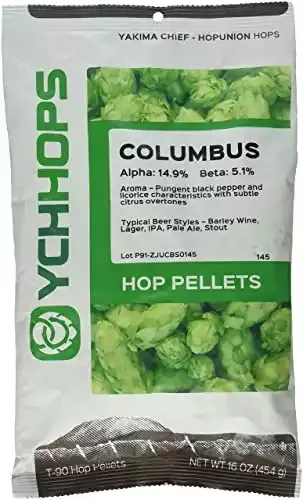
First bred by Charles Zimmerman as part of a USDA breeding program in the 1970s, Columbus has an unknown lineage. It is often referred to as CTZ (Columbus / Tomahawk / Zeus) due to Hopunion and YCH attempting to register the same hop with different names, even though it is genetically distinct from Zeus hops.
Columbus has an earthy, spicy character that works excellently as a bittering hop. Plus, when you use it as an aroma addition, it produces more floral and citrus notes that can be very aromatic.
| Usage: | Dual-Purpose |
| Country of Origin: | United States |
| Hop Growers Code: | CBS |
Where To Buy Columbus Hops
Columbus is a high alpha varietal with a neutral bitterness and intense aroma. A true dual-purpose hop that works very well for bittering, but shines just as easily as a late addition. CTZ hops have an earthy, spicy character that is great for bittering.
Columbus Flavor And Aroma
Columbus is a dual-purpose hop that is often described to have the following aroma characteristics:

black pepper, anise

herbal

dank, resinous
Columbus Hop Oil Breakdown
Hop oils can vary from year to year and farm to farm but based on our research, here are the typical values we have seen reported. This information comes from various hop farms, The Hop Aroma Compendium, and For The Love Of Hops.
| Alpha Acid % (AA) Alpha acids are what is isomerized when boiling to create bitterness in beer. | 14% – 18% |
| Beta Acid % Beta acids are what give hops their more aroma and flavor compounds. | 4.5% – 6% |
| Alpha-Beta Ratio This ratio of alpha acids to beta acids determines how quickly bitterness fades during aging. Lower ratios are common for aromatic varieties. | 2:1 – 4:1 |
| Co-Humulone as a % of Alpha Higher numbers are said to impart a harsher bitterness. | 28% – 35% |
| Total Oils (mL/100g) With more total oils, typically comes a more complex hop profile but these are highly volatile compounds. | 2.5mL – 4.5mL |
| Myrcene green, resinous | 45% – 55% |
| Humulene woody, piney | 9% – 14% |
| Caryophyllene woody | 6% – 10% |
| Farnesene floral | 0.1% – 1% |
| Other Oils: Includes beta-ionine, beta-pinene, limonene, linalool, geranoil & selinene | 20% – 40% |
| Hop Storage Index (HSI) The HSI indicates the percent of alpha and beta acids lost after 6 months of storage at room temperature (68°F or 20°C). | Retains 55% of its alpha acid after 6 months of storage at 20ºC (68ºF). |
| Hop Storage Index (HSI) Rating | Poor |
Columbus Hop Substitutions
Replacing one hop for another is seldom straightforward but sometimes you don’t have the right hop or the right quantity of hops for the beer you want to make. For those situations, we have made a comprehensive list of hops to substitute on brew day.
These substitutions aren’t perfect as hop chemistry is pretty complex.
We wanted to make this list of substitutions with varietals that are easy to find when possible. For Columbus, we recommend substituting with the following hops:
Beer Styles
For the most part, any hop could have a place in just about any beer style. Based on popular beers, historical usage, and our own preferences, we would recommend using Columbus for IPA, New England IPA, Pale Ale, Wheat Beer, Golden Ale. That being said, experiment and see what works best for you.
References
https://www.hopslist.com/
https://www.ars.usda.gov/
https://www.brewersassociation.org/
https://www.barthhaasx.com/
https://www.yakimachief.com/
Hieronymus, Stan. For The Love of Hops. Brewers Publications, 2012
The Hop Aroma Compendium. 2012


